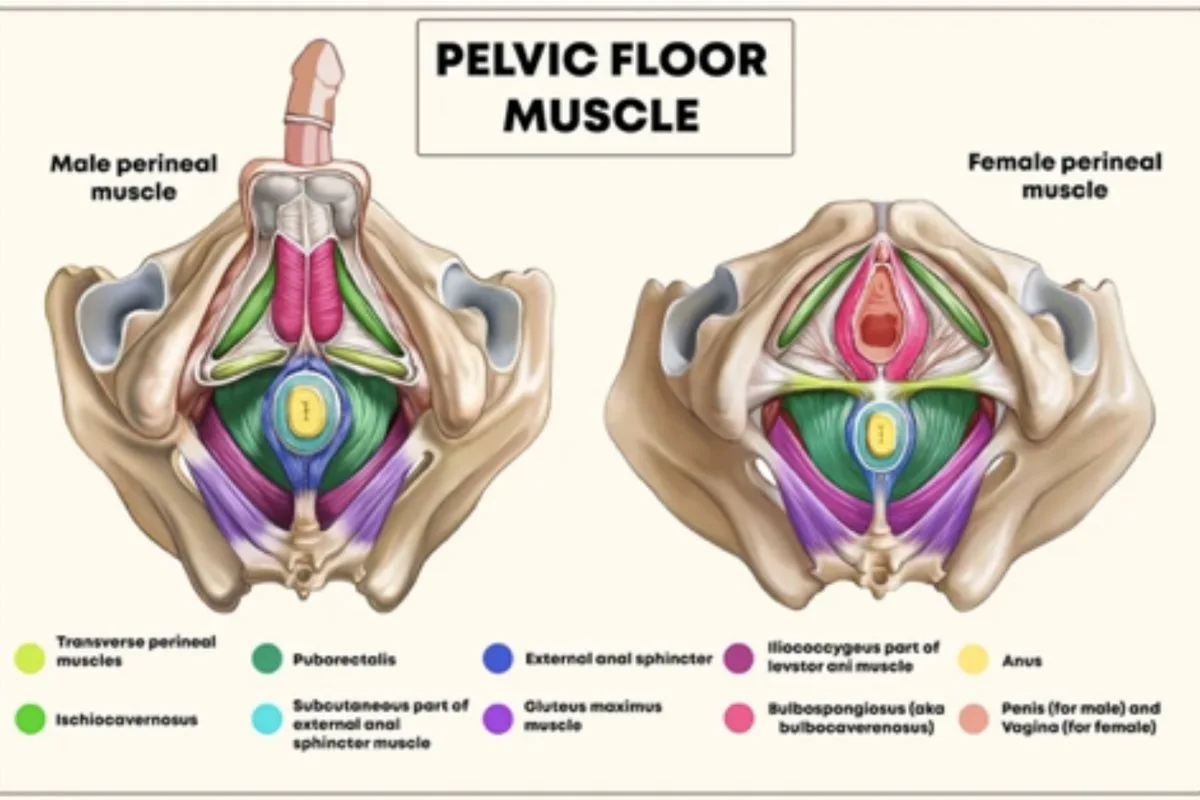1 . What is Pelvic Floor Rehabilitation for Men?
YES! You have read correctly … MEN MIGHT NEED PELVIC FLOOR REHABILITATION, TOO!
The male pelvic floor is located in the lower part of the pelvis and acts as a base or as a “closure” for the abdominal-pelvic compartment, which is the space in which the viscera are located. In a few words and to help us understand further, the pelvic floor in men is that area on which you lean when you are sitting.

Maybe this is the first time you have heard of something called the pelvic floor or, at least, the first time someone has told you that you, as a man, also have a “pelvic floor”. The pelvic floor in men, as in women, is the set of structures that close the lower space of the pelvis. Women usually are the most aware of this area of their body (due to the consequences of things such as pregnancy, childbirth, or menopause have on their bodies), you as a man, also have a few reasons to start taking care of it, and the first step to do this is to know it exists and to learn to feel it.
You may wonder why it is so important to take care of the pelvic floor in men. In reality, it is quite likely that you may not have stopped to think about it. It is important due to these four essential functions that your pelvic floor develops without you noticing in your day-to-day:
- The pelvic floor controls urinary and faecal continence
- Assists a correct emptying of the bladder and bowel
- It supports the pelvic organs (bladder and rectum) and participates in sexual function, with an important role in erection and ejaculation
- Supports and works in conjunction with the lower abdominal muscles to support the pelvis and lumbar spine
A weakened pelvic floor in men, due to factors such as age or uncontrolled physical exercise or oncological treatments, may be related to urinary and prostate problems such as urinary incontinence, constipation or faecal incontinence, erectile dysfunction, pelvic pain and retrograde ejaculation.

Similarly, when a man undergoes prostate surgery, it is important to rehabilitate the pelvic floor through exercises to regain control of his urethral sphincter.
In addition, if the muscles of your pelvic floor are functioning optimally, you can improve the quality of your training performance.
You can tell me the reason why you think you might need my help. Feel free to book an appointment through the clinic or send me an email so I can advise you on when you should get started with rehabilitation. After years of working with men of different ages and nationalities I can tell you that it is never too late to start and that the first step of enquiring is the most difficult one, once you will start with the rehabilitation programme most wish they have started sooner!
2. Benefits of pelvic floor Physiotherapy for Men
Many factors can weaken the pelvic floor muscles, including surgical removal of the prostate (radical prostatectomy) and conditions such as diabetes and an overactive bladder.
Men who partake in impact sports such as mountain biking, running, contact sports, cross-fit and weight-lifting can often suffer the consequences of pelvic floor distress.

You could benefit from pelvic floor rehabilitation if:
- You have urinary or faecal incontinence
- You lose a few drops after urinating, usually after you have left the bathroom
- You suffer from constipation or pelvic pain
- You have been diagnosed with chronic prostatitis
- You suffered a coccyx break or trauma
- You have undergone prostate or pelvic surgery
How do you book pelvic floor rehabilitation for men at anatomy rehab?
You can contact us at Anatomy Rehab directly by email or WhatsApp and we can discuss your individual case to be sure you are suitable for a Mens Health assessment, if you prefer to book an appointment directly feel free to contact the clinic and bring along any urological or related medical reports and comfortable clothes.
During the first assessment, we will establish the diagnosis and treatment plan, and most will see results from the first day.
The therapy will combine exercises, manual therapy, behavioural changes and homework you should be committed to practising.
In some cases, biofeedback training can be helpful with pelvic floor muscle re-training. In a biofeedback session, we will use an electronic device to help you to be aware of the activation and relaxation of your pelvic floor.
All the procedures should be non-painful, and you will always be fully informed about the techniques that will be performed beforehand.
When will The Results be Visible?
If you do the exercises regularly, you will see results much sooner than you can expect! In most cases of pelvic pain, it is common to feel relief after even the first session. For continued benefits, you should continue with the exercises and the behavioural changes as a permanent part of your daily routine.
Do not hesitate to ask any questions you may have. We are happy to answer all of your doubts.
3. Pelvic floor rehabilitation after a prostatectomy: how do you know Physiotherapy can help you?

The laparoscopic radical prostatectomy is very useful in the recovery from prostate cancer. It has prolonged the life expectancy of these patients. Unfortunately, following the surgery, many men experience a decrease in quality of life and present with various types of urinary incontinence problems post-operatively.
We can find, according to different studies, that the incidence of urinary incontinence varies from 0.8 to 87% in these patients.
Postoperatively, the patient may notice symptoms after the removal of the catheter, around two weeks after the surgery. They will commonly be advised to take protective measures like incontinence pads, but this should not become your new reality! With specialist physiotherapy treatment, we can help you get rid of pads, combat incontinence, and regain your previous lifestyle.
It’s scientifically demonstrated that when a specialized Physiotherapist performs a preoperative program prior to prostate, bladder or pelvic surgery, it can reduce the risk of the consequences of urinary incontinence and erectile dysfunction in the long term. However, even if you didn’t undergo pre-operative physio treatment, it is never too late to start with pelvic floor rehabilitation, as you can still get great results postoperatively.
The treatment will take into consideration the anatomy of the pelvic floor muscles, teaching specific contractions of this musculature and taking care to contract and maintain this contraction when carrying out movements or day-to-day efforts. Treatment may also include a voiding diary, intake of water and liquid and avoiding constipation and retention.
After the surgery, it is recommended to complete more specific pelvic floor re-training, often with the help of electrostimulation or biofeedback therapy combined with manual therapy, paying attention to the muscles of the pelvic floor. We will also train the deep abdominal muscles, which are strongly linked to the pelvic floor, and this will make the rehabilitation complete to not only assist with pelvic floor condition but also help you to become more active and conscious of your body as we will make sure that you LEARN how to workout safely for the rest of your life.
Our Men’s Health Specialist Physiotherapist is at your disposal, and as an expert in urology physiotherapy, she will ensure that you feel comfortable and at ease during the whole process. Feel free to send her an email on Marina@anatomyrehab.ae or contact her through the clinic on 055686 1886, she will solve any doubts you might have about when and how to start with treatment.
4. Pelvic floor Physiotherapy after prostate cancer
Sometimes, life surprises us with setbacks that we don’t expect, and we may receive a diagnosis of prostate cancer. The medical procedures and surgery often required to treat prostate cancer can result in symptoms such as the following:
– Voiding drip often occurs when, even after going to the bathroom to urinate, drops of urine escape even after having been careful to “shake” and wait.
– Urinary incontinence is the loss of control over the bladder. Symptom severity can vary with this, and this can be very limiting to one’s life if left untreated.
– Urination urgency: the very sudden and urgent feeling of having to go to the bathroom to urinate and with a feeling that you “can’t hold it.”

– Erectile dysfunction
– Retrograde ejaculation; This occurs when semen is introduced into the bladder instead of going out through the penis.
What can be done?
Pelvic floor physiotherapy/osteopathy has been postulated as a great way to alleviate these often debilitating symptoms after prostate cancer surgery.
As Pelvic floor physiotherapists specialising in men’s health treatment, we can help you by preparing you preoperatively for any surgery or treatment as well as with any symptoms that prostate cancer surgery and treatment generates.
You can follow these four steps to leave nothing to chance and be very effective in your recovery:
First, complete an initial assessment. The assessment is not painful and serves to mark the steps to make a recovery plan. The idea is to start before the surgery, but it is never too late to start!
Track when your symptoms appear and your daily routines. This will be very helpful to adapt the treatment to your own interests and to your lifestyle.
Don’t be afraid or ashamed to seek help for these symptoms. They are much more common than you think. Looking for help is the best option, it is sometimes difficult to talk about these kind of problems so it seems that no one else suffers from incontinence or sexual problems after a prostatectomy but that is untrue!
Don’t settle for any professional! All exercises must be learned individually and personalized in consultation with a specifically trained Physiotherapy specialist. Not all patients are the same and should not perform the same exercises! Rehabilitation can be a long process and requires a lot of discipline on the part of the patient, but being consistent with the rehab will help you return to your normal rhythm of life and activity.
When will you start to see results?
If the assessment and treatments have been completed by a specialist, after a couple of weeks, you will be able to see the results and objectify the improvement. You will notice that the amount of urinary leakage every time is smaller, as is the total number of urinations per day and at night.
The amount of time to see improvement will be different for each patient, the exercises are always individualized and should be reviewed every week to verify that they are performed correctly, progressed and to monitor the effect on your pelvic floor.


